Institutional Knowledge: What It Is and Why It Matters

According to research, only 42% of critical business knowledge is retained in employees’ minds. This means that your company is at risk of losing many thousands of dollars when key workers leave or retire. Without effective institutional knowledge management, your business may suffer from reduced productivity and a slower onboarding process.
Additionally, institutional or tribal knowledge is like a “perishable asset” that depreciates without proper preservation.
In this article, we’ll define institutional knowledge and walk you through the benefits, real-life examples, and a step-by-step guide to building an institutional knowledge management system so your organization can thrive.
What Is Institutional Knowledge?
Institutional or tribal knowledge means collective experiences, understanding, and insights that are accumulated in an organization over time. Unlike explicit knowledge that can be easily documented, institutional knowledge often includes tacit elements, such as unwritten rules and cultural habits that are unconsciously reflected in various processes and workflows.
A company’s institutional knowledge is like a mature forest. In this forest, trees represent the collective memory grown over years of learning, problem-solving, and adapting. The roots are the deep-seated practices that hold the organization together—often unseen, but essential for stability.
Just as a forest thrives through the interconnected ecosystem of plants, animals, and nutrients, an organization relies on the shared knowledge between its people. When a veteran employee leaves, it’s like losing a mature tree—the canopy thins and the ecosystem loses a source of wisdom. However, if this knowledge is captured and shared, it’s like planting saplings that ensure the forest remains vibrant for years to come.
That is why nurturing and preserving institutional knowledge will help you sustain the organization’s growth, adaptability, and long-term success.
Types of Institutional Knowledge
Traditionally divided into explicit and tacit, institutional knowledge can be categorized into several narrower types:
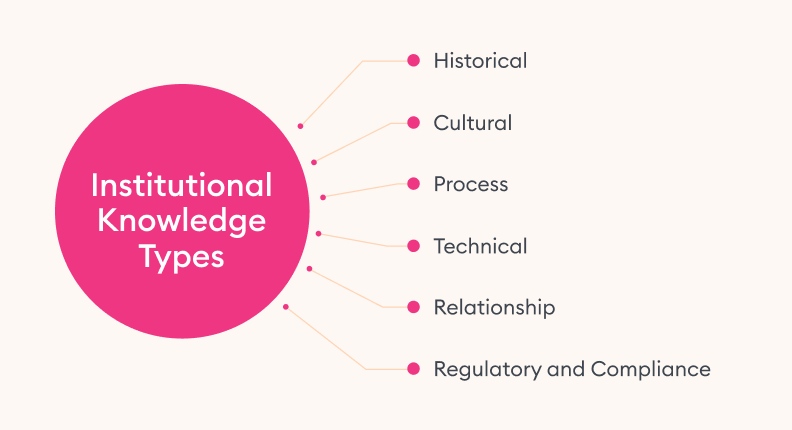
- Historical knowledge involves the organization’s history, such as past projects, strategic decisions, successes, and failures. This explicit knowledge helps companies avoid repeating mistakes and build upon previous experiences.
- Cultural knowledge encompasses the company’s values and behaviors that shape how things are done. It includes everything from communication styles to the unwritten rules that guide employee interactions.
- Process knowledge refers to the internal workflows that employees follow to complete tasks. This includes methodologies for project management, quality control, client engagement, and more.
- Technical knowledge consists of specific skills and technical expertise that employees acquire over time, often unique to the organization’s systems and technologies.
- Relationship knowledge covers the network of contacts and relationships with clients, partners, and stakeholders. This type of knowledge is crucial to maintain business continuity and external collaborations.
- Regulatory and compliance knowledge involves understanding industry-specific regulations and compliance requirements, which ensures that the organization remains legally sound and avoids penalties.
The Importance of an Institutional Knowledge Strategy
An institutional knowledge strategy is like your organization’s safety net. It’s the glue that holds your processes, culture, and innovation together when faced with inevitable changes. With a solid strategy, the departure of a seasoned employee doesn’t mean starting from scratch. Instead, it’s an opportunity to build upon a well-documented foundation of expertise.
Here’s why you can’t afford to ignore this:
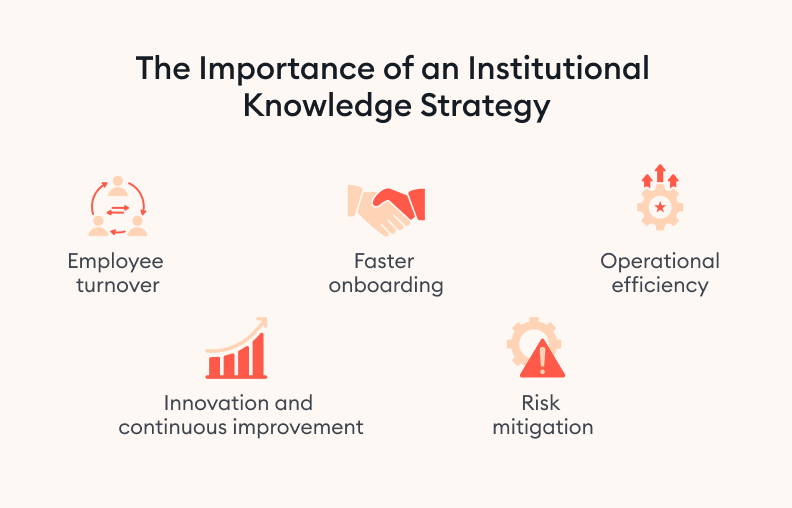
- Employee turnover. Employees quitting or retiring becomes less disruptive when they pass their tribal knowledge to other employees before leaving the company.
- Faster onboarding. New employees hit the ground running with accessible guides and documented insights.
- Operational efficiency. The productivity of your business skyrockets when decisions are informed by institutional memory instead of guesswork.
- Innovation and continuous improvement. Innovation thrives when past lessons propel you forward rather than holding you back because they have been lost.
- Risk mitigation. When you document critical knowledge, you minimize the risks associated with information silos and the sudden departure of key employees.
The Benefits of Implementing Institutional Knowledge Management
Picture this: your employees naturally collaborate, make swift decisions, and spend their time and energy innovating instead of hunting for information. That’s what institutionalized knowledge management provides.
Here’s what happens when you get it right:
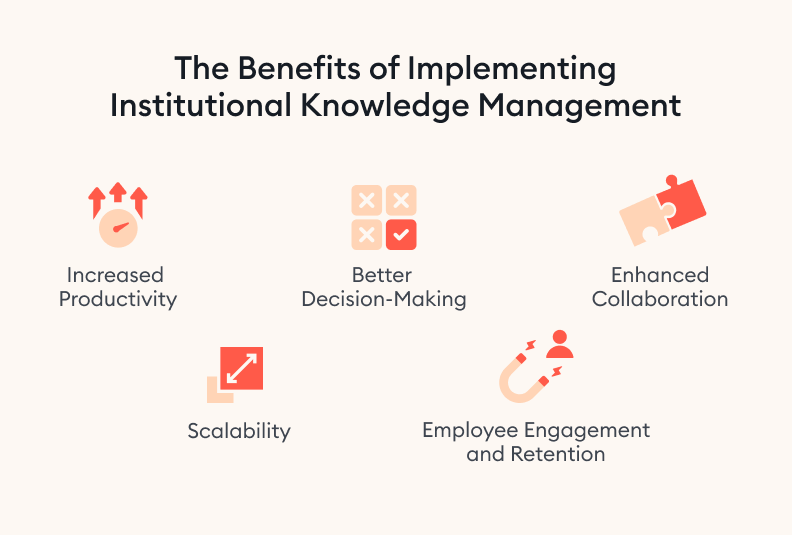
Increased productivity
Studies show that employees spend about 20-30% of their workweek searching for information, which costs companies billions annually in lost productivity. Organizations with effective knowledge management systems experience a 67% improvement in employee productivity by reducing time spent locating critical data.
Better decision making
Companies with effective knowledge management are more likely to make informed, strategic decisions, avoiding errors and maximizing opportunities.
Enhanced collaboration
According to research, successful knowledge management projects encourage and enhance collaboration between employees. Organizations that promote cross-departmental knowledge sharing see an increase in team collaboration effectiveness, which fosters innovation and problem-solving.
Scalability
As businesses grow, poor knowledge management can lead to inefficiencies that cost companies great losses because of operational delays. By streamlining knowledge sharing, you ensure consistent quality and standards.
Employee engagement and retention
92% of workers think workplace training positively impacts their job engagement. They also say they won’t quit if they get training and development opportunities. Empowering employees with knowledge fosters loyalty and engagement.
Examples of Institutional Knowledge
Institutional knowledge isn’t just a buzzword, it’s the foundation for your company’s ability to adapt and excel. Real-world examples bring this to life. They show how leveraging knowledge transforms challenges into opportunities and turns siloed teams into collaborative powerhouses.
IBM: Turning knowledge into a competitive advantage
At IBM, the mantra is simple: collective wisdom drives success. To make the most of its talent pool, IBM rolled out the “Knowledge Exchange”, a global platform for sharing expertise and fostering innovation. Through Communities of Practice (CoPs), employees with shared interests could collaborate to solve problems and spark new ideas. They combined this with Lotus Notes, a tool for real-time discussions and document sharing. Additionally, IBM introduced incentives like promotions and financial rewards to motivate employees to contribute their best ideas. The result? A dynamic, learning-focused culture where knowledge flowed freely across departments.
The impact was profound. Employees became faster, more effective problem-solvers, and collaboration soared. CoPs emerged as incubators for innovation, empowering IBM to stay ahead in the fast-paced tech industry. This approach didn’t just protect organizational knowledge, it transformed it into a driver of growth and leadership.
Procter & Gamble: Open innovation, big wins
Procter & Gamble took knowledge sharing to the next level with its “Connect + Develop” initiative, proving that innovation thrives with collaboration. In an attempt to leverage expertise across its global workforce, P&G decided to go for open innovation. The company invited external partners—universities, researchers, and inventors—to pitch in with fresh ideas, expanding its innovation ecosystem beyond company walls. Internally, a collaborative platform allowed employees to share best practices and build on each other’s insights.
This strategy delivered iconic results. Products like Swiffer and Febreze became household names, thanks to the streamlined development pipeline made possible by this initiative. P&G didn’t just accelerate innovation—it created a culture where breakthroughs were celebrated with rewards like recognition, career growth, and bonuses fueling the momentum. By blending internal and external knowledge, P&G set a standard for innovation-driven businesses.
How to Save Institutional Knowledge in an Organization
If your business operates in an industry with high turnover or specialized expertise, it would be a good idea to maintain your competitive edge by creating an internal institution of knowledge. Here are several strategies companies can implement to save and transfer institutional knowledge effectively.
Create a centralized knowledge repository
The first and most natural way to preserve institutional knowledge is to create a centralized knowledge base where all employees can access vital information. This could be in the form of an internal wiki, a cloud-based document management system, or a dedicated knowledge management platform. Surprisingly, not so many businesses have such systems in place, and not all employees know how to document their work, so it might take some extra effort to introduce the new practice and get all your personnel on board.
What to include: Standard operating procedures (SOPs), process documentation, troubleshooting guides, best practices, and internal policies.
Benefits: This approach ensures that all employees have access to the same information, reducing the risk of knowledge silos and making it easier for new hires to onboard quickly.
Introduce a learning management system
Using a learning management system like iSpring Learn is another powerful way to capture and organize institutional knowledge. iSpring Learn is an intuitive LMS that allows organizations to create, store, and deliver training content. It can encompass the entire array of information about how things work in your company and help employees learn in a comfortable environment with zero confusion.
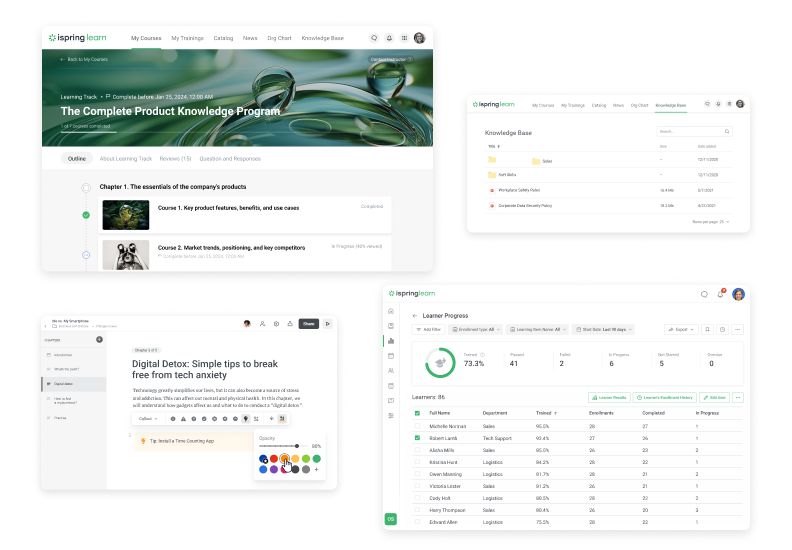
How an LMS supports knowledge management
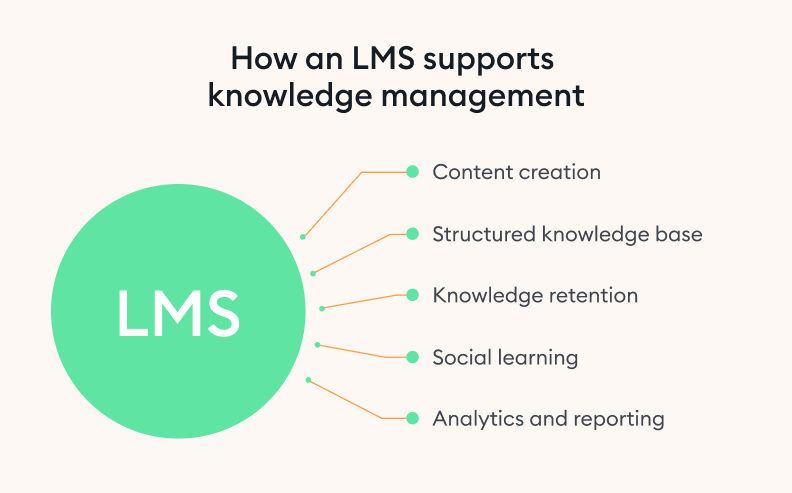
Content creation. With iSpring’s built-in authoring tools, your learning and development department can easily create tutorials and interactive modules to capture the valuable expertise of seasoned employees. For instance, an experienced sales manager could create a course on effective sales techniques, complete with video demonstrations and quizzes.
Structured knowledge base. iSpring Learn allows organizations to create a structured knowledge base where employees can access training materials, recorded webinars, video tutorials, and FAQs. This ensures that critical knowledge is available on-demand, 24/7.
Knowledge retention. To ensure that information is retained, iSpring Learn includes features like interactive elements and quizzes, which reinforce learning retention over time. This is especially useful for preserving complex knowledge that might otherwise be lost.
Social learning. The platform supports social learning by enabling discussions in comments, so employees can ask questions and collaborate. This peer-to-peer interaction can uncover tacit knowledge that may not be documented, but is invaluable for day-to-day operations.
Analytics and reporting. iSpring Learn provides detailed analytics on course completion rates, quiz scores, and learner engagement. This helps HR and L&D teams identify knowledge gaps and track the effectiveness of their training programs.
Case study
Jitasa is an accounting and bookkeeping service provider for nonprofits that employs 400+ people and serves 1,300+ clients. It used iSpring Learn to build a strong training support system across multiple branches in different countries. This resulted in a reinforced corporate culture and a new hire onboarding process that was reduced by one or two months.
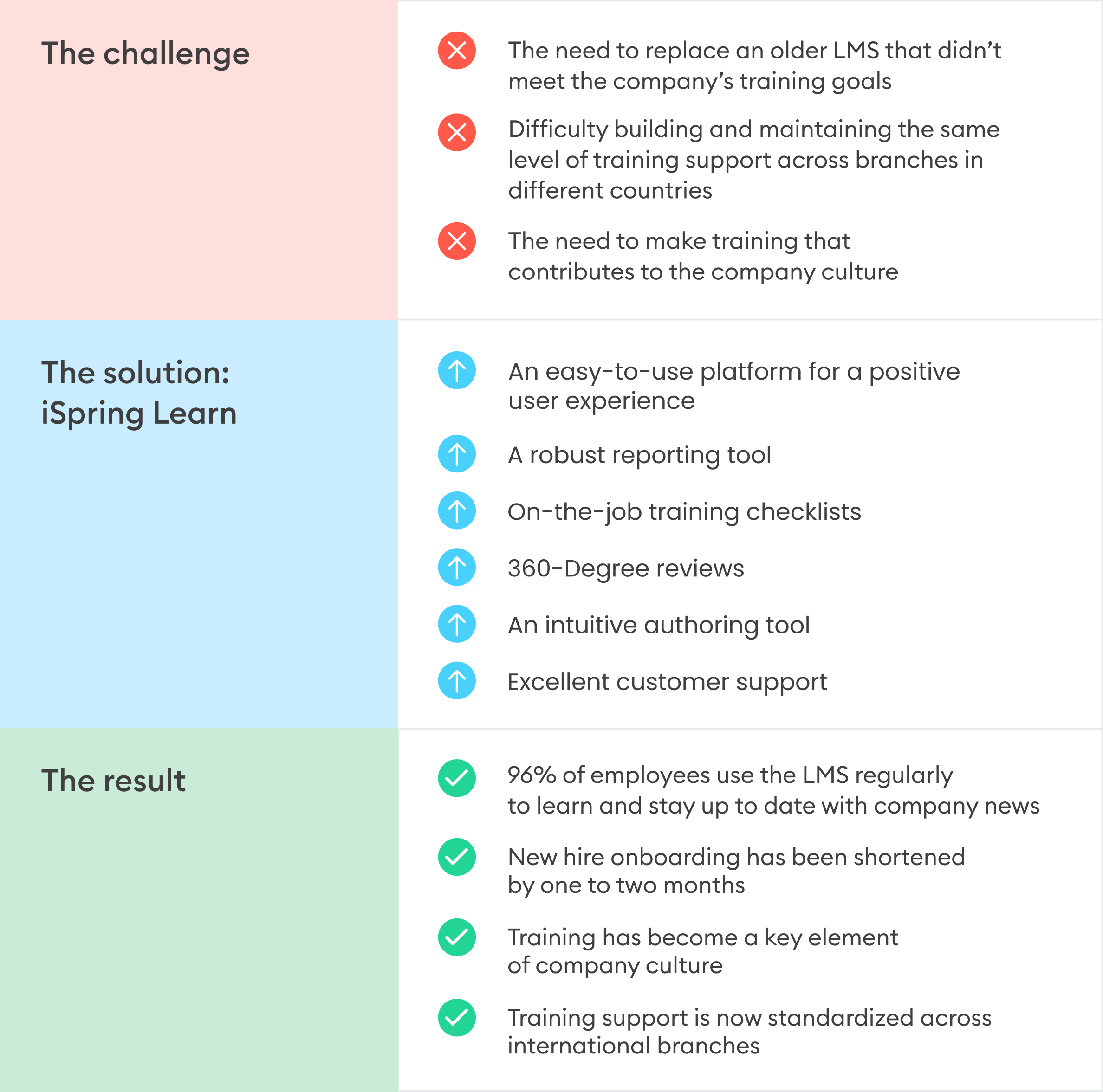
Encourage documentation of processes and best practices
Documenting institutional knowledge is the cornerstone of knowledge management. Encourage employees to document their workflows and best practices, and you’ll significantly reduce the risk of losing critical knowledge when key employees leave.
How to get started
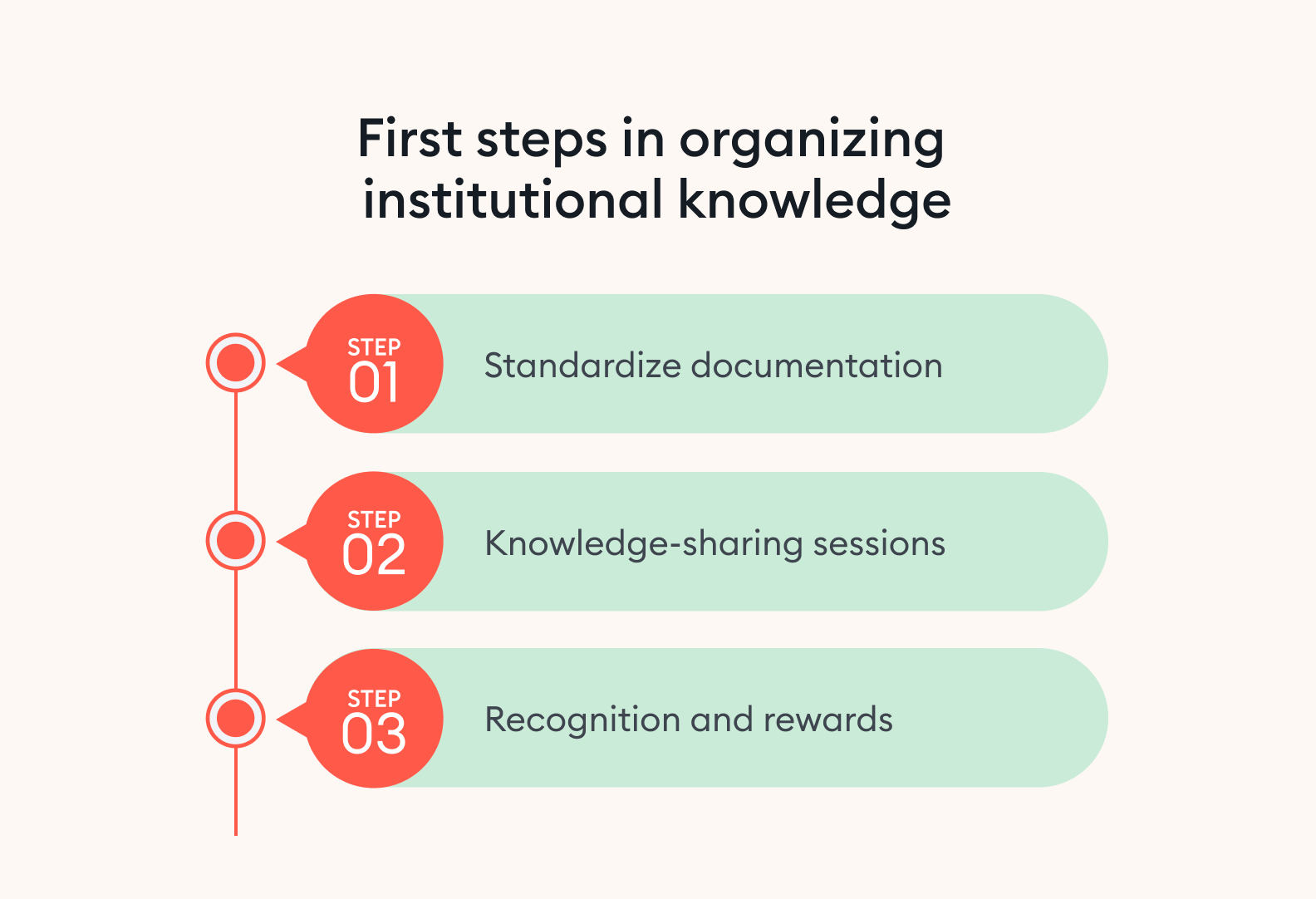
Standardize documentation. Use templates to standardize the documentation process, making it easier for employees to record their knowledge in a consistent format.
Knowledge-sharing sessions. Host regular knowledge-sharing sessions in which employees can present their processes and tips to colleagues. Record these sessions and upload them to your LMS or knowledge repository.
Recognition and rewards. Motivate employees to contribute to documentation efforts by recognizing their contributions in company meetings or providing incentives like bonuses or gift cards.
Leverage technology for real-time knowledge capture
In addition to traditional documentation, leveraging technology can help capture institutional knowledge in real time. Thanks to the advancement of technologies, we have tools like video conferencing, screen recording software, and chatbots that make the process extremely easy and convenient.
Actionable strategies:
Record meetings and training sessions. Use tools like Zoom or Microsoft Teams to record meetings and training sessions. Upload these recordings to iSpring Learn, where they can be indexed and searched for future reference.
Use AI-powered search. Integrate AI-powered search functions within your LMS or knowledge repository to help employees find the information they need quickly. This reduces time spent searching for documents and improves productivity.
Implement knowledge transfer programs
Formal knowledge transfer programs are essential for capturing the existing institutional knowledge that experienced employees hold. This can be done through mentorship, job shadowing, and cross-training initiatives.
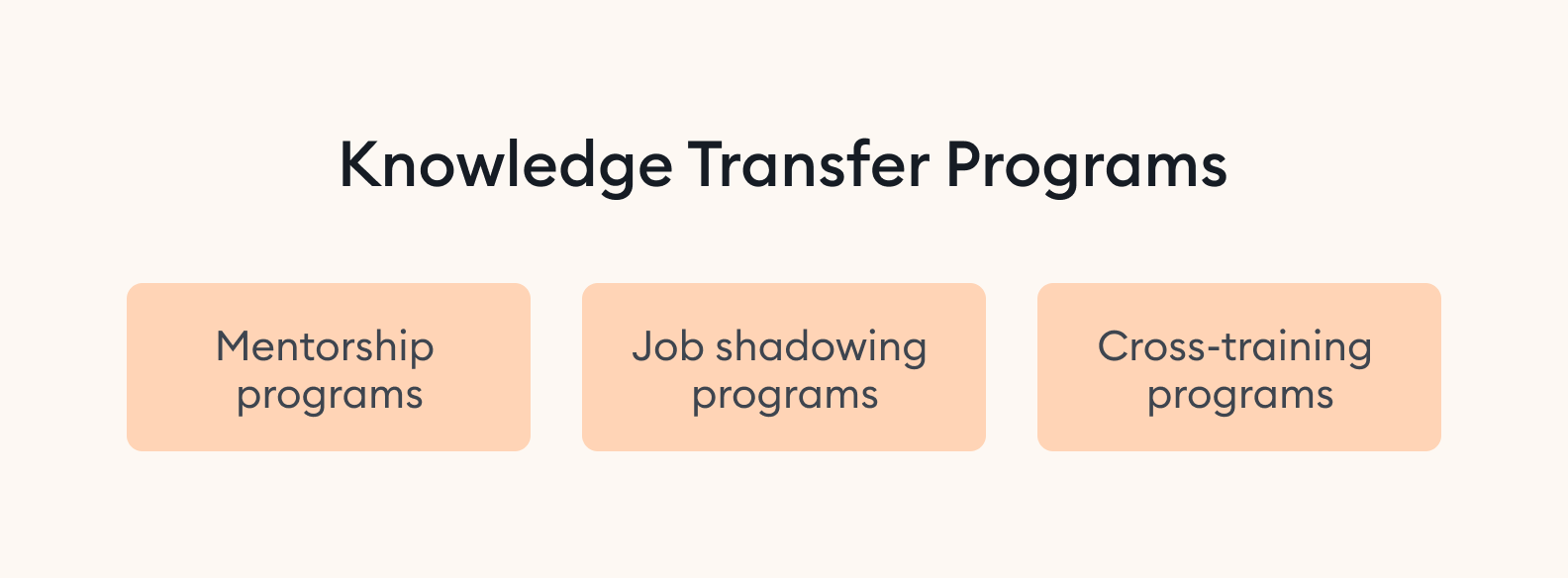
Mentorship programs. Pair senior employees with new hires or junior staff. The mentor can share their experiences, answer questions, and provide insights that are not found in manuals or SOPs. Document this mentorship to the degree that this is possible.
Job shadowing. Allow employees to shadow experienced colleagues to learn how tasks are performed in real time. This is especially useful for complex roles where hands-on experience is key.
Cross-training. Rotate employees through different departments or roles to ensure a broader understanding of the business. This reduces the risk of knowledge gaps if someone leaves unexpectedly.
Conduct exit interviews and knowledge capture
When employees leave the organization, especially those in critical roles, conducting exit interviews can help capture valuable knowledge. This is an opportunity to document insights, strategies, and best practices that can be passed on to their successors.
How to maximize exit interviews:
Structured questionnaires. Use structured questionnaires focused on capturing process knowledge, client relationships, and project insights.
Recorded sessions. With permission, record the interview and use the transcript to create a written knowledge guide.
LMS integration. Upload the insights from exit interviews to your LMS, tagging them appropriately for easy retrieval.
Promote a culture of continuous learning and knowledge sharing
Institutional knowledge preservation is not just about tools and processes; it’s about creating a culture where knowledge sharing is valued and encouraged.
Actionable steps:
Encourage peer-to-peer learning. Use your LMS’ social features, such as discussion forums and learning communities, to facilitate peer-to-peer knowledge sharing.
Leadership support. Ensure that leadership actively supports and participates in knowledge-sharing initiatives, setting an example for the rest of the organization.
Regular training and refresher courses. Regularly update your LMS with new courses, best practices, and industry trends to keep the workforce informed and engaged.
FAQ on Sharing Knowledge in the Workplace
What is the meaning of institutional knowledge?
- Definition: institutional knowledge refers to the information, expertise, processes, and insights accumulated by employees within an organization over time.
- Key aspects: it includes everything from workflows and client preferences to the company culture and historical decisions.
- Why it matters: this knowledge forms the backbone of operational efficiency, employee training, and organizational growth.
How can institutional knowledge be accumulated?
- Document processes: encourage employees to document workflows, decisions, and best practices in centralized systems like a knowledge management platform.
- Encourage mentorship: pair new hires with experienced employees to facilitate informal knowledge transfer.
- Promote collaboration: use tools like Slack, Microsoft Teams, or dedicated knowledge-sharing platforms to facilitate information exchange.
- Invest in training: regular workshops, onboarding programs, and upskilling sessions help in generating and retaining valuable tacit and explicit knowledge.
What is an example of institutional memory?
Imagine a senior project manager who knows the history of how your company has handled client disputes. This includes what worked, what didn’t, and why certain approaches were adopted. This is institutional memory in action. If captured or recorded, institutional memory helps organizations avoid repeating past mistakes and allows them to build on successes.
How can institutional knowledge be preserved?
- Leverage technology: implement tools like the iSpring Learn LMS or SharePoint for the storage and sharing of centralized knowledge.
- Create a culture of sharing: instruct your Human Resources department to reward employees for contributing to knowledge databases to ensure continuous updates.
- Plan for succession: use exit interviews and transition plans to capture critical knowledge from departing employees.
- Encourage documentation: provide templates and guidelines to standardize how knowledge is recorded across teams. That way, the tribal knowledge of your organization won’t get lost.
Why is institutional knowledge important?
- Enhances efficiency: Employees spend less time reinventing the wheel and more time innovating.
- Reduces turnover risks: Capturing tribal knowledge provides continuity, even when key employees leave.
- Drives competitive advantage: By leveraging unique insights and practices, companies stay ahead of competitors.
- Supports growth: Retaining institutional knowledge forms the foundation for scaling operations without losing quality or consistency.
Conclusion
In this article, we’ve defined institutional knowledge as the lifeblood of a thriving organization, connecting past experiences to future potential. As businesses face rapid changes in technology, workforce dynamics, and global competition, preserving and leveraging this knowledge is no longer optional—it’s essential.
To build a resilient, knowledge-driven organization, leaders must prioritize a culture of continuous learning. Whether through mentorship programs, innovative platforms like iSpring Learn, or open innovation strategies, the way forward is clear: treat knowledge not as a static resource, but as a dynamic, evolving asset. By doing so, your organization not only secures its legacy but also builds a future where expertise drives success at every level.







